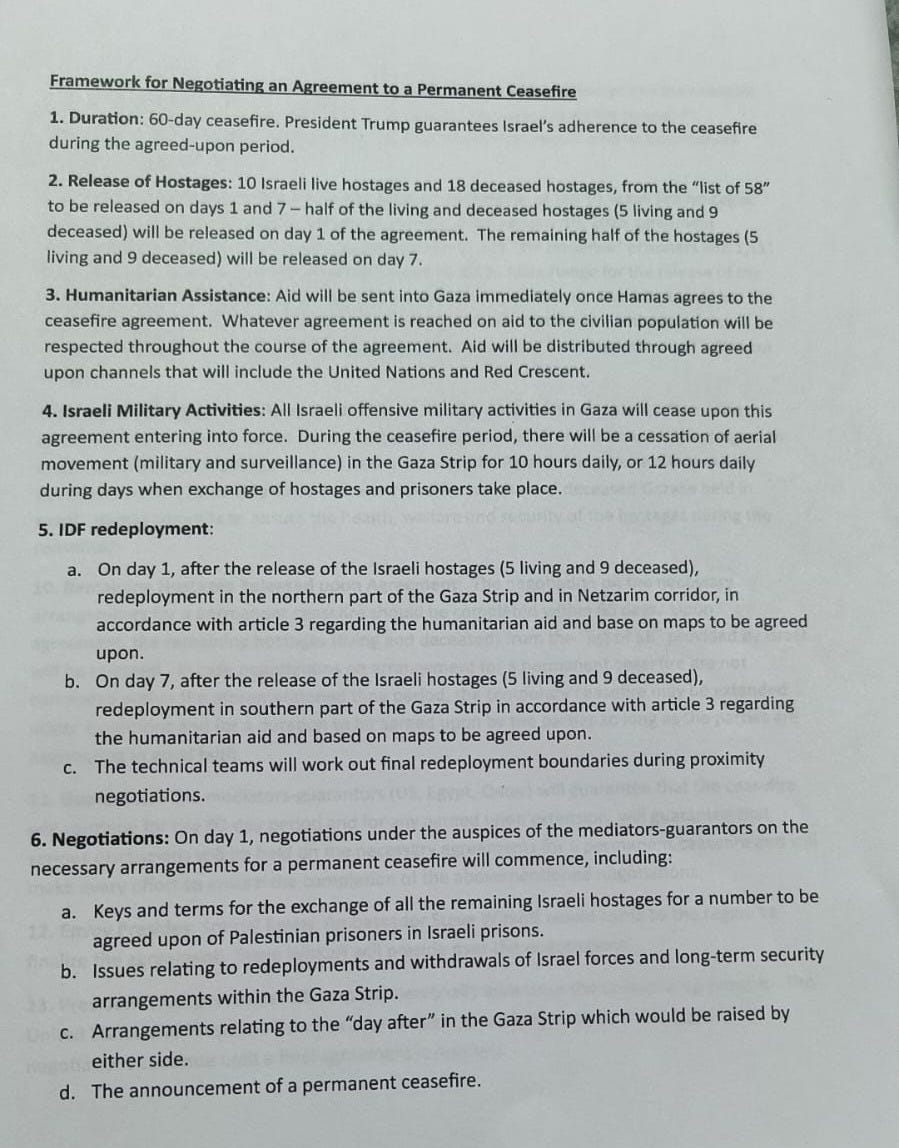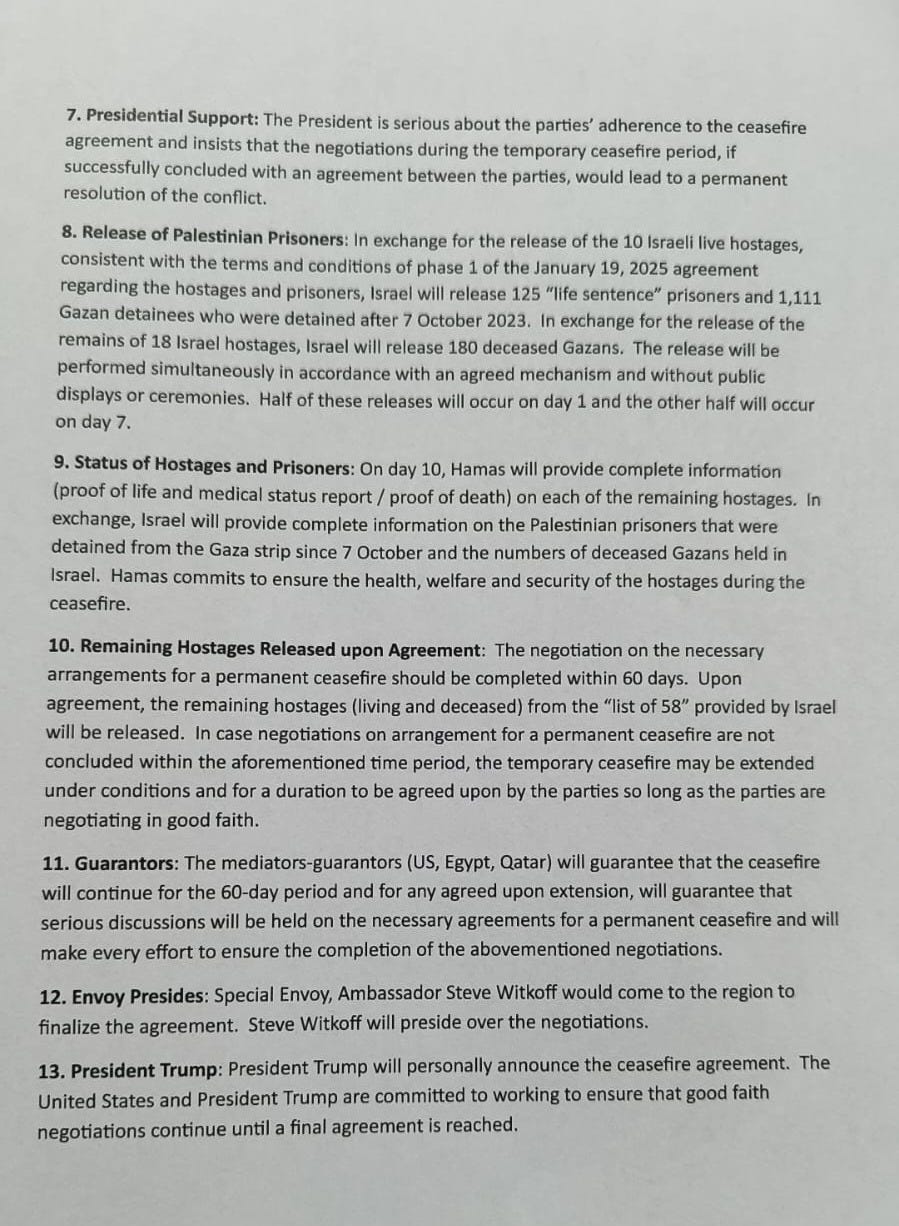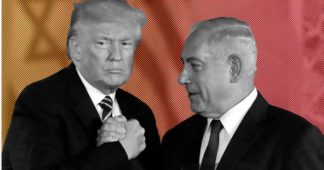Jeremy Scahill, Sharif Abdel Kouddous, and Jawa Ahmad
May 29, 2025
Drop Site obtained the “term sheet,” circulated by Steve Witkoff. It would allow Israel to resume war after 60 days.
A new proposal for a Gaza ceasefire spearheaded by Donald Trump’s special envoy, Steve Witkoff, includes a 60-day initial truce, a “redeployment” of some Israeli occupation forces, and an exchange of captives, including ten living Israelis held in Gaza. It would also require the “immediate” delivery of humanitarian aid, including by the United Nations and the Red Crescent. Drop Site obtained a copy of the document, labelled a “term sheet” by Witkoff.
Israeli Prime Minister Benjamin Netanyahu announced today that Israel had accepted the proposal, asserting it would allow Israel to continue its war of annihilation. “We agree to accept the outline that was conveyed to us tonight,” Netanyahu said. “We do not believe Hamas will release the last hostage, and therefore we will continue fighting until Hamas is destroyed, and we will not leave the Gaza Strip until all the hostages are in our hands.”
If finalized, the agreement would be personally announced by President Trump and states that Trump “guarantees Israel’s adherence to the ceasefire during the agreed-upon period.” “Witkoff would come to the region to finalize the agreement,” it states, and to “preside over the negotiations.”
Hamas confirmed it had received the Witkoff proposal and said it “is responsibly studying it in a way that serves the interests of our people, provides relief, and achieves a permanent ceasefire in the Gaza Strip.”
On Wednesday, Witkoff announced the U.S. was on the verge of sending the term sheet to Hamas and Israel for approval. “I have some very good feelings about getting to… a temporary ceasefire and a long-term, peaceful resolution of that conflict,” he said while standing alongside Trump in the Oval Office.
Most concerning to Hamas, according to officials who spoke to Drop Site, is that the proposal contains substantive amendments to an “understanding” Hamas announced it had reached with the U.S. on Monday. On Tuesday, Hamas issued a statement it had reached “an agreement with U.S. envoy Steve Witkoff on a general framework that achieves a permanent ceasefire, a complete withdrawal of occupation forces from the Gaza Strip, the flow of aid, and the appointment of a professional committee to manage the Gaza Strip’s affairs immediately after the agreement is announced.”
The new Witkoff proposal, however, includes only vague language on whether the agreement would lead to a complete end to the genocide and a full withdrawal of Israeli forces from Gaza. “The President is serious about the parties’ adherence to the ceasefire agreement and insists that the negotiations during the temporary ceasefire period, if successfully concluded with an agreement between the parties, would lead to a permanent resolution of the conflict,” the document states. “The United States and President Trump are committed to working to ensure that good faith negotiations continue until a final agreement is reached.”
The new draft also makes no mention of an independent committee to administer Gaza, a term Hamas said was in its original agreement with the U.S.
“The proposed deal from the Israelis through Witkoff is extremely difficult to accept,” said a senior Hamas official to Drop Site. “There is no talk about the [ceasefire] deal from January 19. There is no talk about a return to the situation before March 2” when Israel abandoned the original ceasefire. The Hamas official said that there is no guarantee Israel would even respect the 60-day truce after its ten captives are returned in the first week of the deal. “They might launch the war again,” he said. “There are no guarantees to a permanent ceasefire, no guarantees for a permanent withdrawal.”
The United States, Egypt, and Qatar, according to the term sheet, would guarantee the 60-day ceasefire as well as “for any agreed upon extension” and would “guarantee that serious discussions will be held on the necessary agreements for a permanent ceasefire and will make every effort to ensure the completion of the above mentioned negotiations.”


On Thursday, a senior Palestinian resistance figure told Drop Site that Hamas is still debating the language in the draft. He pointed out that the assurances about Trump’s commitment to a long-term ceasefire are not enforceable and that Israel repeatedly violates ceasefire agreements, including the January deal that Trump pushed through before his inauguration. “Releasing half [of the living Israeli captives] within a week and then putting your hopes in Trump is not very reassuring,” he told Drop Site.
Basem Naim, a member of Hamas’s political bureau, told Drop Site earlier this month that the group had received a direct commitment from Witkoff that two days after the release of U.S. citizen and Israeli soldier Edan Alexander, the Trump administration would compel Israel to lift the Gaza blockade and allow humanitarian aid to enter the territory. Witkoff, according to Naim, also promised that Trump would make a public call for an immediate ceasefire in Gaza and for negotiations aimed at achieving a “permanent ceasefire.”
“He did nothing of this,” Naim said. “They didn’t violate the deal. They threw it in the trash.”
Hamas officials have consistently told Drop Site they will not agree to any proposal that does not include a clearly defined framework for a total end to the genocide and the withdrawal of Israeli forces. Prime Minister Benjamin Netanyahu has said Israel will not agree to terms that prevent it from resuming its war of annihilation against Gaza.
“There are a lot of reservations on this paper as a framework. There are a lot of loopholes. There are a lot of ambiguities,” a Palestinian source close to the negotiating team told Drop Site. “Israel will never agree to end the war under this framework. The number of aid trucks are not mentioned. There are no specifics about where the Israeli forces will withdraw to. All of these are problems which will probably impede this. Witkoff tried to accommodate Israel much more than what was in the earlier paper. It’s going to take some time before a deal gets approved by the movement.”
Soon after the Witkoff draft was circulated, Israeli officials told several Hebrew language news outlets that the vague language in the draft would allow Netanyahu to resume the war after 60 days. A senior Israeli official, according to Ha’aretz, suggested that “U.S. officials deliberately crafted ambiguous language around the issue of ending the war to make the deal acceptable to both sides,” pointing out that the proposal “does not include a demand for Israel to end the war or withdraw from Gaza.”
Speaking to YNet, Israeli officials said securing a partial deal for half the remaining living and dead captives is a victory for Israel that increases the chance of another partial deal because Hamas’s bargaining power will be reduced. “If there is an opportunity for a temporary ceasefire to return additional hostages, I would like to emphasize: We are ready for a temporary ceasefire,” Netanyahu said on May 21. Hamas officials told Drop Site that the group will not release more Israeli captives until there is a clearly defined framework for ending the genocide.
Israeli officials also boasted to YNet that, under the terms of the Witkoff paper, “Israel is not giving up its strategic achievements,” claiming that the framework will allow Israeli forces to remain entrenched along the Philadelphi Corridor along Gaza’s southern border with Egypt.
Under the agreement, aid would be sent into Gaza “immediately once Hamas agrees to the ceasefire agreement.” The process for allowing aid into Gaza is not completely clear, though the proposal does specify that the UN would be involved in distribution: “Whatever agreement is reached on aid to the civilian population will be respected throughout the course of the agreement. Aid will be distributed through agreed upon channels that will include the United Nations and Red Crescent.”
It is not clear from the document if the Gaza Humanitarian Foundation would continue to operate or would be disbanded. The U.S. and Israeli-backed aid distribution mechanism has been denounced by the UN and dozens of international humanitarian organizations after going into effect this week in Gaza with disastrous results, including at least 10 Palestinians being killed by occupation forces.
The ceasefire framework includes a schedule for the release of ten living and 18 deceased Israeli captives. Half would be released on the first day of the agreement and the rest on day seven. There are a total of 58 Israeli captives still being held in Gaza, 20 alive, 35 confirmed dead, and three whose status Israel says remains unknown. In exchange for Hamas releasing ten living Israeli captives, Israel will release 125 Palestinian captives with life sentences and 1,111 captives from Gaza who were detained after October 7, 2023. “The release will be performed simultaneously in accordance with an agreed mechanism and without public displays or ceremonies,” the document states.
All Israeli offensive military activity would cease upon the agreement going into effect. During the initial 60-day ceasefire period, Israel would also cease all aerial movement, including surveillance, for between 10 to 12 hours daily.
Crucial technical details are not outlined in the term sheet, including the point to which Israeli ground troops would be required to pull back. The proposal only states that troops would redeploy in northern Gaza and in the Netzarim Corridor on day one of the agreement based on maps that still need to be negotiated. Israeli troops in southern Gaza would redeploy under similar terms on day seven. According to the term sheet, “The technical teams will work out final redeployment boundaries during proximity negotiations.” Over 80% of the Gaza Strip is currently within an “Israeli militarized zone” or under active displacement orders, according to the UN.
The terms for exchanging captives are consistent with the previous ceasefire agreement in January—one that Israel violated on a near daily basis and eventually abandoned entirely, imposing a full spectrum blockade on March 2 and resuming its genocidal military campaign in full force on March 18. In exchange for the release of 18 the bodies and remains of dead Israeli captives, Israel would release 180 dead Palestinian captives from Gaza. The proposal specifically bans any “public displays or ceremonies” during the release of captives.
The document also states that on day ten of the ceasefire, Hamas would provide “complete information (proof of life and medical status report /proof of death)” on each of the remaining Israeli captives, while Israel would provide the same on Palestinian captives detained from Gaza since October 7. It does mention Palestinian captives detained by Israel in the West Bank, dozens of whom remain disappeared and their status is unknown. The proposal also calls on Hamas to commit “to ensure the health, welfare and security of the hostages during the ceasefire,” with no provision for Palestinian captives held by Israel. At least 70 Palestinians have died in Israeli detention over the past 19 months.
Nearly 4,000 Palestinians have been killed in Gaza since March 18 alone, when Israel resumed its scorched-earth bombing campaign followed by an expanded ground invasion. Over 430,000 Palestinians have been forcibly displaced again over that time period. Meanwhile, a nearly three-month Israel blockade has left one hundred percent of Gaza’s population facing “high levels of food insecurity,” according to the UN, and the entire enclave is on the brink of famine.
As Israel’s genocidal assault on Gaza crossed the 600-day mark on Wednesday, UNOCHA declared the humanitarian situation is “at its darkest point yet. As relentless, deadly bombardment and mass displacement intensify, families are being starved and denied the basic means of survival.”
This story has been updated to include new comments from a Hamas official and another Palestinian source.
We remind our readers that publication of articles on our site does not mean that we agree with what is written. Our policy is to publish anything which we consider of interest, so as to assist our readers in forming their opinions. Sometimes we even publish articles with which we totally disagree, since we believe it is important for our readers to be informed on as wide a spectrum of views as possible.











